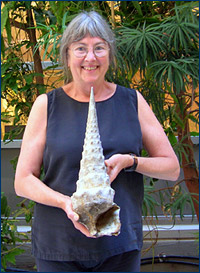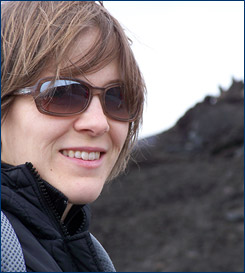
Carole Hickman
Changes at UCMP: Two retired and two hired
This past spring, two longtime professors and UCMP faculty curators retired: Carole Hickman and Jere Lipps. Carole and Jere have each made significant contributions to UCMP's reputation in both teaching and research for a combined 52 years (31 and 21 years respectively). As emeritus faculty, they will continue to pursue their research interests.
Stepping in to bolster paleontology instruction at Cal are two new faculty members: paleobotanist Cindy Looy and evolutionary biologist Charles Marshall.
We are pleased to highlight the careers of Carole and Jere and introduce Cindy. Charles, who will be arriving in January of 2010, will be profiled in the next issue of UCMP News.
Carole Hickman
 Carole Hickman |
Over the course of her career, Carole has received numerous honors and awards. She was elected fellow of the California Academy of Sciences, the American Association for the Advancement of Science, and the Geological Society of America. In 1994, she was awarded a Research Professorship from the Miller Institute for Basic Research in Science at UC Berkeley and the Gilbert Harris Award in 2003 "in recognition of excellence in systematic paleontology" from the Paleontological Research Institution.
Carole's research is wide ranging — both conceptually and geographically. She studies the morphology of living and fossil snails. Her research combines biology, paleontology, and geology. The best part about research, says Carole, is working in the field. Her research has taken her across the globe, from California's Channel Islands to the Galapagos, Hawaii, New Zealand, French Polynesia and four sabbaticals in Australia.
Carole's legacy includes more than 100 peer-reviewed publications, including four book-length monographs; 16 former graduate students who have positions at leading institutions; 55 species named (as well as six genera and ten families, subfamilies and tribes), and five species named in her honor. For Carole, retirement is definitely not the end of her career. She plans to use her extra time to write a book about the principles of structure — the rules that determine the morphology of organisms. Carole is currently working on several different projects. One involves snail specimens collected in Indonesia in 1909, during the USS Albatross Expedition. "There are three new genera and eight new species. They're absolutely spectacular material … It's time to get this stuff published." The main reason to retire, says Carole, is "so you can do what you love full time." And what Carole loves is research.
Jere Lipps
 Jere Lipps |
Jere published over 400 technical papers, abstracts, reviews, books, and magazine articles, over 165 of which are in peer-reviewed scientific journals. He was elected fellow of the Geological Society of America, the American Association for the Advancement of Science, the Cushman Foundation, the Paleontological Society, and the California Academy of Sciences. His numerous honors and awards include the Antarctic Medal of the U.S. for his work in Antarctica from 1971–1980, the prestigious Cushman Award in 2006 for Excellence in Foraminiferal Research, and he has just been named the Raymond C. Moore Medalist for Excellence in Paleontology for 2010 by the Society for Sedimentary Geology. Perhaps his greatest honor came from the Antarctic Board of Geographic Place Names: a small island near Palmer Station was named Lipps Island in his honor.
While at Berkeley, Jere taught an array of courses, from Introductory Biology to Marine Micropaleontology to Astrobiology. He also taught the very popular Biology and Geomorphology of Tropical Islands at the Gump South Pacific Research Station in Moorea, French Polynesia. Over the course of his career, Jere advised nearly 50 graduate students. He also worked to improve the scientific literacy of the American public. In 1998, the National Center for Science Education awarded him the Friend of Darwin Award in recognition of these efforts. Much of Jere's research focuses on the biology and ecology of foraminifera, shelled protists abundant in the fossil record. But he also studied other taxa from early metazoans to whales to modern reef systems, travelling all over the world to do so. Despite his retirement, Jere will continue to conduct research on forams and other marine biota. He is also working to encourage the formation of paleo parks — fossil localities that should be preserved and protected from damage due to development, over-collecting, vandalism, and paleopiracy.
 Cindy Looy |
As a plant ecologist who works in the past, Cindy looks at the response of plants and their communities to major environmental change and the possible evolutionary consequences. Cindy studies the impact of the Late Paleozoic deglaciation on the evolution and geographic distribution of conifers and their paleocommunities. Cindy's findings, from a field site in north central Texas, indicate that early conifers have been around for much longer, and were more diverse, than previously thought.
Cindy also studies the changes that occurred during and following the mass extinction at the end of the Permian, about 250 million years ago. She does much of her fieldwork for this project in South Africa, where she works with a multidisciplinary group of collaborators.
Cindy's research is question-driven: she asks a question, and then figures out the techniques she'll need to answer that question. This often requires an interdisciplinary approach, using organic geochemistry, carbon-isotope analysis, and biostratigraphy, in addition to other techniques commonly used in palynology, paleobotany and paleoecology. Because her research often stretches her in new directions, Cindy is looking forward to collaborating with others — establishing links between paleobotany, plant ecology, and plant physiology is high on her list. Cindy is also looking forward to working with graduate students: "They will probably ask questions I would never have thought of."
Carole Hickman photo by Dave Smith, UCMP; Jere Lipps photo courtesy of Jere Lipps; Cindy Looy photo courtesy of Cindy Looy